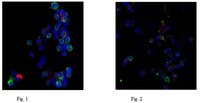The sunburn response in human skin is characterized by sequential eicosanoid profiles that may mediate its early and late phases.
Rhodes, Lesley E, et al.
FASEB J., 23: 3947-56 (2009)
2009
Mostra il sommario
Sunburn is a commonly occurring acute inflammatory process, with dermal vasodilatation and leukocyte infiltration as central features. Ultraviolet (UV) B-induced hydrolysis of membrane phospholipids releases polyunsaturated fatty acids, and their subsequent metabolism by cyclooxygenases (COXs) and lipoxygenases (LOXs) may produce potent eicosanoid mediators modulating different stages of the inflammation. Our objective was to identify candidate eicosanoids formed during the sunburn reaction in relation to its clinical and histological course. We exposed skin of healthy humans (n=32) to UVB and, for 72 h, examined expression of proinflammatory and anti-inflammatory eicosanoids using LC/ESI-MS/MS, and examined immunohistochemical expression of COX-2, 12-LOX, 15-LOX, and leukocyte markers, while quantifying clinical erythema. We show that vasodilatory prostaglandins (PGs) PGE(2), PGF(2alpha), and PGE(3) accompany the erythema in the first 24-48 h, associated with increased COX-2 expression at 24 h. Novel, potent leukocyte chemoattractants 11-, 12-, and 8-monohydroxy-eicosatetraenoic acid (HETE) are elevated from 4 to 72 h, in association with peak dermal neutrophil influx at 24 h, and increased dermal CD3(+) lymphocytes and 12- and 15-LOX expression from 24 to 72 h. Anti-inflammatory metabolite 15-HETE shows later expression, peaking at 72 h. Sunburn is characterized by overlapping sequential profiles of increases in COX products followed by LOX products that may regulate subsequent events and ultimately its resolution. | 19584301
 |














